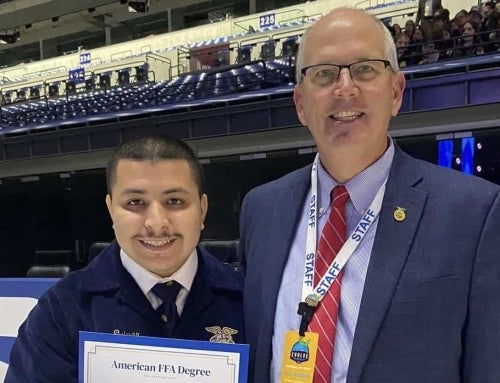
Photo by Ana Verahrami / Invictus Images
Whether you’re gearing up for college or preparing for your next semester, figuring out how to cover your college costs isn’t an easy hurdle for a lot of students. The good news is that there are plenty of scholarships out there that can help. The tough news… you’ll be competing with other students to earn one.
Don’t worry, though – you have options! Your GPA and extracurricular activities certainly play a part, but knowing where to look for scholarships can make a big difference in your search to ease higher education’s financial burden. Check out these tips to help you identify and apply for all kinds of scholarships:
1) Start Right Here with FFA
If you’re reading this post on FFANewHorizons.org, chances are you’re interested in an agriculture-related career. Many job sectors have scholarships available through related clubs, organizations and businesses. For example, you could earn a $1,500 scholarship through the America’s Farmers Grow Ag Leaders program, which is sponsored by the Monsanto Fund in conjunction with the FFA. The scholarships can be used at two- or four-year universities and trade schools for ag-related fields of study, including mathematics, computer science, business, communications, engineering, farming, agronomy, education and more. This year, the program will award more than $500,000 in scholarships.
You can learn more on the FFA Scholarships Page or by visiting GrowAgLeaders.com.
2) Complete the FAFSA
Many scholarships require students to complete the Free Application for Federal Student Aid (FAFSA). You can begin filling out the FAFSA on October 1 of the year before you need aid, but you should also take note of your state’s application deadline since many need-based scholarships give priority to those who have completed the FAFSA. Also, some colleges and universities may have earlier deadlines.
3) Use Your Resources: Counselors and Financial Aid Offices
High school counselors are a great resource for leads on scholarships as many scholarship providers send them information on award offerings and applications. Financial aid offices can also help find specific awards by major for both new and returning students. Be sure to pay attention to newsletters and bulletin boards outside of the counselor or financial aid offices as they may help you find more leads on scholarships.
4) Find Scholarships that Require a Little More Effort
Don’t pass over scholarships that have bigger requirements, like essays, video submissions or projects. Though it might require extra time, remember that a tougher application process might discourage other applicants from applying, making a smaller candidate pool. And, more often than not, more requirements equal larger monetary values.
5) Go for the Smaller Award Amounts, Too!
Every little bit counts. Each scholarship you receive – even smaller, one-time award amounts – can be used to pay off books, supplies or living expenses. Many times, scholarships with smaller award amounts have fewer additional requirements.
6) Discover New Leads Using a Scholarship Search Engine
Because there are so many scholarships out there, there are dedicated scholarship search engine websites. While some sites might make you buy a subscription, the free ones, like Scholarships.com, Fastweb and Scholarship America, can provide options based on your personal profile. And don’t forget industry-specific websites, like FFA.org, that can direct you to scholarship opportunities that pertain to your field of interest.
If you’re interested in the America’s Farmers Grow Ag Leaders program, learn more or apply at FFA.org/scholarships or check out GrowAgLeaders.com. Also, be sure to follow America’s Farmers on Facebook.











